Click on the link for the shared document for your time session.
9 AM – https://docs.google.com/document/d/1oMxaT-utPP1io_1EsOsrnsfWMOdH2z-u8kcr6oq0prs/
10:30 AM – https://docs.google.com/document/d/1ZvbfbmXTNZFS4ue5yfR29CA3CcY1_EMVAEi5UII0xuE/
Citizen, Educator, & Environmental Scientist
Click on the link for the shared document for your time session.
9 AM – https://docs.google.com/document/d/1oMxaT-utPP1io_1EsOsrnsfWMOdH2z-u8kcr6oq0prs/
10:30 AM – https://docs.google.com/document/d/1ZvbfbmXTNZFS4ue5yfR29CA3CcY1_EMVAEi5UII0xuE/
STINK! takes its viewers on the drawn-out journey of a single father simply wishing to do best by his children, to cope with the untimely death of his wife, and to learn what produced the odor coming from newly purchased pajamas for his tween daughter. The quest for chemical information follows a tortuous trail…
Structured in many ways like any contemporary documentary film, STINK! takes its viewers on the drawn-out journey of a single father simply wishing to do best by his children, to cope with the untimely death of his wife, and to learn what produced the odor coming from newly purchased pajamas for his tween daughter. The quest for chemical information follows a tortuous trail, moving from consumers to retailers to manufacturers with each segment enjoined with regulators, legislators, and lobbyists. Along the way Jon Whelan learns what many chemical scientists already know, manufacturers are not required to disclose to the consumer all the ingredients in a given product. At the end of the film, now knowing the identity of likely offenders in the pajamas, the audience is left to consider a lingering question. Will the disclosure and labeling requirements associated with product ingredients continue along the Business as Usual trajectory where some of the content can be hidden or will we see a disruption in this practice because of the public’s concern about their health and environmental health?
The strongest supporting storyline involves Rose and Brandon, a mother-son team battling Brandon’s severe allergic response to AXE Body Spray. AXE is a highly marketed, sexualized, deodorant product produced by Unilever. Rose makes inquiries to Unilever about the possible chemical to which her son reacts only to be given no assistance in the matter. The family physician wants to do a myriad of chemical tests to determine the culprit, and Brandon simply wants to know what to avoid so he can return to school. Even with the community support, minutes after entering the school Brandon is hit with an AXE scent, forced to use his EPI-PEN, and sent to the hospital. This scenario plays out frequently for parents of children with severe allergies and chemical sensitivities every day in schools, churches, and on family vacations.
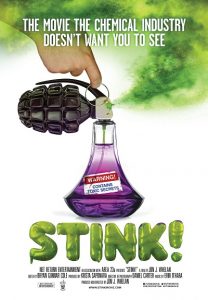 While the film does a reasonable job illustrating how manufacturers use trade secret protections and the fragrance exception to limit full disclosure on ingredient labels, it missed a number of opportunities. Excellent examples from chemical classes of concern make appearances in the film; however, the simple truth that we and all living organisms live in a natural and toxic chemical soup gets no play. Human beings are not the only organism that creates highly toxic chemicals or to be exposed to naturally occurring toxicants. Just think about arsenic, lead, and mercury or the host of botanicals – foods and herbs – not fit for human use and consumption. In addition the film fails to lift up the positive practices across the chemical enterprise – companies promoting full disclosure and doing things different. No mention of the practice of green chemistry enters any frame, and this year, 2016, marks the 20th anniversary of its introduction. These points represent critical omissions. While it is inconvenient to layer this nuanced approach to the chemical enterprise, it is honest and essential.
While the film does a reasonable job illustrating how manufacturers use trade secret protections and the fragrance exception to limit full disclosure on ingredient labels, it missed a number of opportunities. Excellent examples from chemical classes of concern make appearances in the film; however, the simple truth that we and all living organisms live in a natural and toxic chemical soup gets no play. Human beings are not the only organism that creates highly toxic chemicals or to be exposed to naturally occurring toxicants. Just think about arsenic, lead, and mercury or the host of botanicals – foods and herbs – not fit for human use and consumption. In addition the film fails to lift up the positive practices across the chemical enterprise – companies promoting full disclosure and doing things different. No mention of the practice of green chemistry enters any frame, and this year, 2016, marks the 20th anniversary of its introduction. These points represent critical omissions. While it is inconvenient to layer this nuanced approach to the chemical enterprise, it is honest and essential.
As noted journalist and author, Deborah Blum states, “Everything is built by chemistry. I am. My chair, my table…an intricate mosaic of interactions; this incredible dance of chemical elements creates everything around us.” This film reminds us that for years creative human beings employed chemical principles to fashion new materials that extend the ability of our species to thrive. Over the last 60 years we slowly re-awakened to the limits of that creativity, namely the less than positive consequences of material design, intentional and unintentional, on human and environmental health. Citizen consumers can make change and even disrupt business as usual by purchasing materials from companies willing to disclose all their ingredients, by supporting manufactures following the principles of green chemistry, by getting educated, by engaging in the political process, and by befriending a scientist, like me.
Lights, camera, action! Enjoy the show.
I thought it would be good to use composting as a way to introduce something my spouse and I call, One Step Forward. The One Step Forward framework provides some background information about a given topic, a few how-to’s, and resources you can use to learn more about the topic or pursue your own actions.
The following question was posed to a Food Coop employee, “What is one thing everyone can do to live more sustainably?” An honest answer came back. “One thing our family struggles with–because we don’t have the systems in place–is composting. It’s not hard, and it’s something we all could do. And, it could be an easy way to get your kids involved, especially because a lot of kids are learning it at school.” As a consequence of this question and answer, I thought it would be good to use composting as a way to introduce something my spouse and I call, One Step Forward. The One Step Forward framework provides some background information about a given topic, a few how-to’s, and resources you can use to learn more about the topic or pursue your own actions.
Rather than start with the composting process, let’s take a quick look at the origins of materials that go into composts. In your home the places of origin typically include the kitchen, indoor plantings, and the yard (or other green space). Here we are generally talking food wastes and yard/plant trimmings. If you take a look at the latest information on the municipal solid waste stream in the United States, you quickly see nearly 30% of the weight consists of these two categories. Much of this material finds its way into gigantic holes in the ground and is buried. Unfortunately, much of the material in a landfill does not decompose very quickly. Researchers have pulled out 70+ year old newspapers and years old banana peels. The specific landfill conditions greatly impact the decomposition rate of its contents. If you want to learn more about the contents of landfills or about garbage, look at the late William Rathje’s Tucson Garbage Project, read the book Garbology (nerd alert: Ann Marie and I love this book), or find a copy of the National Geographic ChannelMegastructures episode titled, Garbage Mountain. Composting and recycling can reduce and potentially eliminate this contribution to the waste stream.
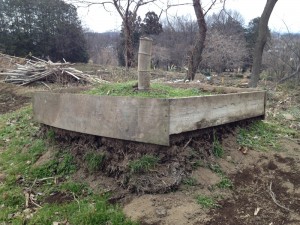
Composting takes advantage of the natural processes used to break down organic matter, materials composed primarily of carbon, hydrogen, oxygen, nitrogen and a few other elements. Good compost strikes a balance among the properties of the input materials. A roughly 2:1 mixture of browns (carbon rich materials) and greens (nitrogen rich materials) yields a pile that will feed the naturally occurring microorganisms and generate the final product in a reasonable time. So what are some examples of browns and greens? Think dry materials for browns, such as dried leaves, sawdust, shredded newspaper, or even the fabric from the Three Tines studio. Food scraps, coffee grounds, fresh grass clippings, and newly pulled weeds all fall into the greens category. Avoid placing high fat materials or meats into the compost bucket. You need much higher temperatures to break down these kinds of materials most effectively. Once you have your brown and green mixture add water – just the right amount of moisture. I like to describe this as the amount of water needed to form the mixture into a ball that holds its shape and doesn’t drip. Now, you will be feeding organisms that need oxygen to survive. As a consequence, you simply mix the pile at some regular interval, perhaps daily or every other day, to get air to all corners.
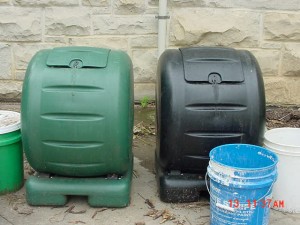
In the kitchen collect your food scraps in a simple bucket with a lid and keep it under the sink. Periodically empty the bucket into the location of your compost bin or bins. I have seen homes with limited space use a prefabricated bin that tumbles the contents, such as the envirocycle, or employ a compact system in a yard using the green cone when small amounts of waste are generated. A larger compost bin or set of bins can be constructed of reused lumber, such as old pallets, or purchased as an assembly. Whatever your situation composting provides an experimental learning adventure, removes wastes from landfills, and generates a rich material to use as fertilizer in your gardens or in your potted plants. For additional information, check out the Rodale Book of Composting, your local extension service, or the quick start guide for home composting.
Enjoy these new adventures by taking One Step Forward and let me know how it goes!
Post originally appeared at ThreeTines.com/Blog
On a hilltop tucked into the northern section of the Kanto Plain in Tochigi Prefecture, Japan is the Asian Rural Institute (ARI), a rural leadership training center and working organic farm. ARI grows and prepares over 90% of what they eat, including fresh fruit, vegetables, rice, wheat and soybeans.
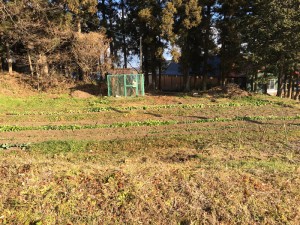
On a hilltop tucked into the northern section of the Kanto Plain in Tochigi Prefecture, Japan is the Asian Rural Institute (ARI), a rural leadership training center and working organic farm. ARI grows and prepares over 90% of what they eat, including fresh fruit, vegetables, rice, wheat and soybeans. In addition they raise pigs, chickens, fish and goats while only occupying 9 hectares (22 acres) of land. They do this all while training rural leaders from around the world to promote peace AND deal with the ever present legacy of the March 11, 2011 earthquake, tsunami, and contamination associated with the Daiichi nuclear power plant meltdown.
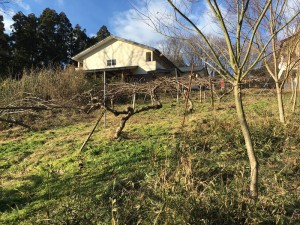
It is all this that brought me from Minnesota to Japan to lead a one-month environmental research course at ARI. While the students worked on their research projects they were also required to participate in what ARI calls “Food Life” responsibilities. Each day the crop and vegetables team (comprised of college students, ARI staff and volunteers) harvested and delivered produce to the kitchen while the animal team provided fresh, cleaned eggs – sometimes in light snow! Remember that ARI only brings in 10% of its food; the rest comes from their organic farm. Staples such as ground wheat, rice, and pressed oils are accessed in large storage containers, and a few cold cellars keep recently dug root vegetables and greens crisp. How does this suite of material get transformed into food on our plates? The short answer – it takes a community – a cooking community.
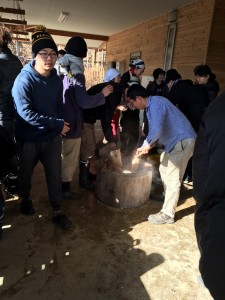
Every day different members of the ARI community – volunteers, staff, and participants – take responsibility for preparing meals. A few of my students, who were a bit unfamiliar with the kitchen, got quite wide-eyed when they were expected to cook – not only cook, but invited to create dishes reminiscent of home. How does one blend cuisine from Japan, Philippines, India, Germany, Thailand, Norway, Cameroon, South Africa, and the United States? Well, it gets… interesting. Every meal becomes an adventure and a creative expression. The kitchen becomes a place of meaningful conversation where people share their life’s stories and how food deeply connects them to memories and to other people. While cutting vegetables for a Philippine inspired noodle stir-fry we discovered how Gil became interested in animal husbandry and studied veterinary medicine before coming to ARI. After volunteering to make six different sheet cakes for an upcoming wedding, we learned about Nagaland, a mountainous state in Northeast India, home to the groom and his cousin, the latter an ARI staff member. There is nothing like learning to bake cakes with freshly ground wheat flour. Being a chemist has some advantages, especially in the kitchen! The German volunteers periodically experimented with ingredients – trying to replicate dishes inspired from home with ingredients found in the ARI kitchen. Even though the seasons put certain limits on the ingredients and rice found its way into every meal, the imaginative efforts of the human mind gave us numerous variations to enjoy.
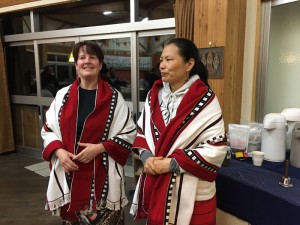
In each and every case, the food simultaneously served as an offering and an invitation. Expressions of individual or small group collaboration offered sustenance, thanksgiving for the food resources, and respect for the time and energy it took to plant, nurture, harvest, prepare and cook. After the food was delivered to the tables all were invited to partake in the cross-cultural adventure laid before them. We listened to stories and told stories – about ourselves, our hopes and dreams, and our aspirations for the world. Sitting around the table sharing food three times a day provided the stage for building a community at ARI and in extending that community outward into the world that we may live together.
Enjoy the opportunities to live together around your table or that of another! Peace.
This post originally appeared on threetines.com
One of the distinct advantages of working with undergraduates, is the creative, inquisitive energy they bring to the table. This month I threw them into the deep end. I asked them to develop some collaborative research projects, define their contributions to the project, and work with a community partner in a country other than their own.
One of the distinct advantages of working with undergraduates, is the creative, inquisitive energy they bring to the table. This month I threw them into the deep end. I asked them to develop some collaborative research projects, define their contributions to the project, and work with a community partner in a country other than their own. Our hosts at the Asian Rural Institute (ARI) graciously accepted the idea of pursuing lines of inquiry that would assist them in delivering their own rural leadership training program and provide insights into the operation of their organic farm on about 9 ha of campus and rented lands. Thus far I have been quite impressed with their determination to pursue lines of inquiry and be challenged by limits on the technology that could be applied to their questions.
The crew of seven students spent the first few days at ARI exploring the landscape, brainstorming project ideas, and talking about their individual and collective interests. What came out of those interactions was two overarching ideas: 1. Systems, subsystems and transfer to of processes and ideas to new locations; and 2. Landscape recovery from the 2011 Daiichi event, with particular interest in the forest-soil relationship.
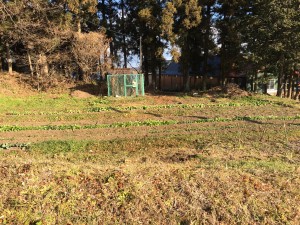
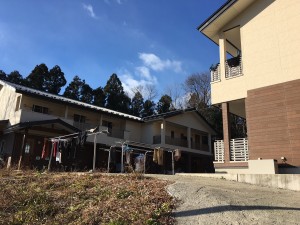
Some member of the first group are exploring how ARI systems for quick composting (Bokashi) can be modified for a larger African participant group, who use more wheat and maize compared to rice. They created new bokashi recipes from ARI materials, log temperature development in those piles as a measure of their effectiveness, and want to help staff and future ARI participants visualize the organisms that make the system function, including indigenous microorganisms. A few others are creating system diagrams and supporting narratives. One plans to illustrate how all components of maize can be used in different ways at ARI, and the other is examining past participant information regarding system components readily transferred to other countries for small scale hog/pig rearing.
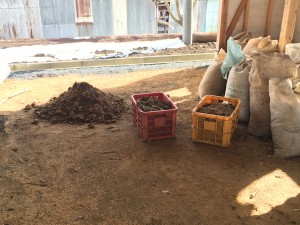
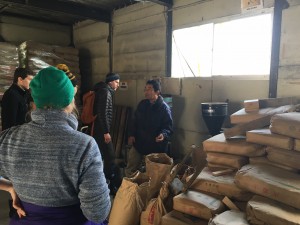
The landscape team got very interested in the continued recovery post the March 2011 Daiichi event. In particular, one student who went to a full-day session on Fukushima at the 2015 American Geophysical Union meeting, was very interested in movement of radioactive material in the soil system. Others wanted to know how much of these radioisotopes were still present in the forest canopy. Rather than climbing tall trees, we retooled to look at the forest floor litter – upper most surface (recent growth) and the litter-soil interface (older growth). Our Japanese colleagues at the ARI Becquerel Center have provided valuable assistance to use in sample preparation and specifications for using their equipment. It is a wonderful story – how local retired scientists with expertise in nuclear medicine have been partnering with ARI to analyze food and landscape samples for the last four years and plan to operate for at least ten years. Lastly we have set up a few camera traps to help our ARI friends understand other organisms that use the landscape or that might be of concern for their animal rearing programs. Within a few days, we captured some predators lurking near one of the chicken houses!
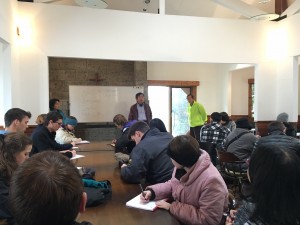
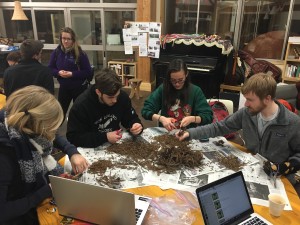
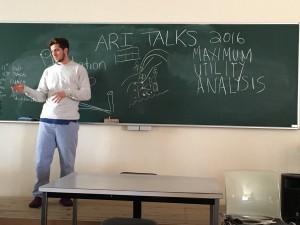
I am quite excited to see what kinds of stories the resulting data, analysis, and synthesis reveal. Right now I think our community partner will be very pleased as will these young women and men doing the work! Enjoy the images of our collaborative learning journey.
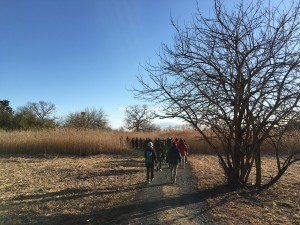
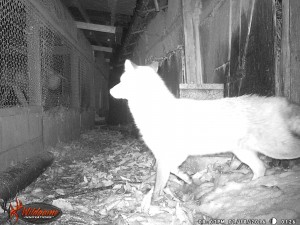
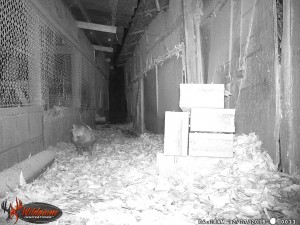
A haiku in honor of the 2014 ACM-SAIL Contested Spaces learning seminar in Colorado and to a great rafting team. There is tremendous opportunity in this experience to consider how integral theory applies to thinking about environmental learning, action, and reflection.

On the river, five
rafting down the Arkansas
Kelsey as our guide
Clear water gushes
carrying our craft downstream
destination awaits
Eddies, waves, currents
forcefully nudge us around
rhythm songs abound
Browns Canyon rock walls
speak of past earth history
continuing today
Laughter, joy, concern,
anticipation, relief
care, my rafting team
While theory provides a wonderful guide, it is the experiment, the action, and the practice that allows us to grow, to construct knowledge and to create and foster relationships. Practice reveals that meaningful work comes in a variety of forms. It makes visible our natural and social connections while inviting one to explore and even live to one’s values.
Theory guides and experiment decides. This statement, first espoused by Izaak Kolthoff, serves as the often cited motto of the subdiscipline Analytical Chemistry, and it is a subdiscipline of which I am a part. The motto complements the two goals of the scientific process: discovery, the generation of new knowledge and ideas, and reduction to practice, the application of knowledge and ideas. Often discovery gets a majority of the attention, but it is the reduction to practice that excites me. It speaks to the consequences (intended and unintended) of the discovery. In addition it reinforces the ideal that learning is intimately connected to knowledge construction and to experience. You can have one without the other, but it isn’t as rich or as fun. Growing up these ideals took root in the everyday living on my uncles’ dairy farms. The first time I was stepped on by one of the three-quarter ton cows clearly demonstrated that the theory about how to convince an animal to move in the way you wanted was far different than practice. Planting, harvesting and tending to the landscape depended on the weather as much as the knowledge and ingenuity of the laborer. While building and remodeling homes to help pay for college, I frequently witnessed arguments between two foremen, who happened to be relatives, about the best way support a cantilevered floor or bring two roof angles together in an aesthetically pleasing yet functional fashion. This life-learning illustrated how the best laid plans change for a project as soon as the activity begins. The system gives feedback and teaches – if I listen.
I try to model listening to the system as a teacher-scholar, and it is reflected in my work on local and global environmental issues, the leading of interdisciplinary efforts, and the use of scientific data in decision-making as part of civic life. I invite students to become multidimensional problem solvers, and to learn as much as they can about the systems and the stakeholders. While working on a local trout stream the team converses with volunteers, elected officials, agricultural practitioners, and land owners about their concerns as well as past and present experience with the landscape. It always yields insights into forces that have shaped the ecosystems we inhabit as well as teaches us about our common humanity. By reflecting on environmentally focused volunteer and work experiences, I and my fellow learners receive more than any textbook or constructed class experience could provide. A few excerpts read:
I didn’t realize the amount of interest and concern the community had about the environment.
There are people who share my values.
People listened…and understood what I said.
Working and conversing with strangers is scary and fun. I have made new friends.
I was amazed by the amount of work we accomplished in so little time.
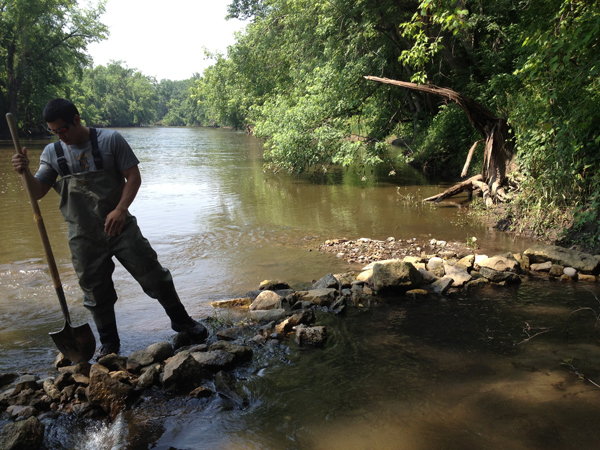
While theory provides a wonderful guide, it is the experiment, the action, and the practice that allows us to grow, to construct knowledge and to create and foster relationships. Practice reveals that meaningful work comes in a variety of forms. It makes visible our natural and social connections while inviting one to explore and even live to one’s values. Ultimately, we discover we are all in this together, and that we give to our neighbor and to our own education by learning through practice. As a result, I would slightly modify my opening statement to say, I believe theory guides, experiment and practice decides.
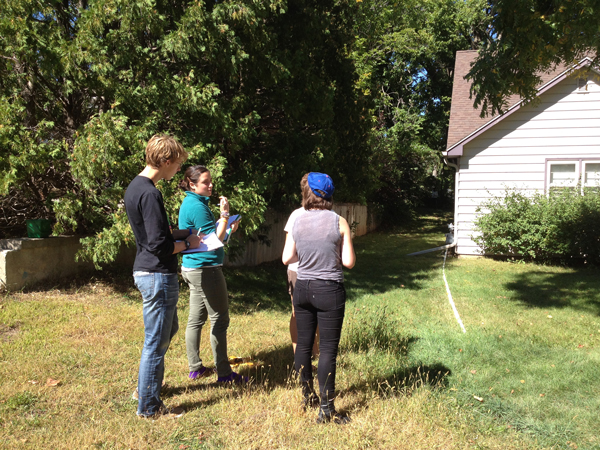
From the “This I believe” address to 2015 Minnesota Campus Compact Summit & Awards, 16 Apr 2015, St. Catherine University, St. Paul, MN.
I felt a profound sense of connectedness and spirit in this place. I listened to the fluttering of birds on wing, the pace of fellow travelers making music with footsteps in the small stones, the wind moving branches and leaves, and to the warmth of the sun shining into my spirit.
Having arrived in Japan on 11 January and meeting up with the ASES 277 group and Asian Con crews this evening, I thought I would take the day to return to some places I traversed 19 months ago when Ann Marie, Kathy, Mike Thai, and Gabriel Trejos-Duran spent two weeks in-country. On today’s docket – sunshine, Meiji Jingu, and the fashion district around Harajuku. Fascinating thoughts and contrasts kept rushing into my head during my walking excursion today; I will share a select few.
When I last spent time at Meiji Jingu, it was mid-June, light rain, and a beautiful swath of blooming irises graced the grounds. Today was bright sunshine, a stiff cool breeze, and a mix of blue sky with browns and greens coupled to the celebrations associated with the New Year, weddings, and an ice sculpture exhibit. As I was meditating in the gyoen (inner garden), designed and built for Empress Shoken by Emperor Meiji I felt a profound sense of connectedness and spirit in this place. I listened to the fluttering of birds on wing, the pace of fellow travelers making music with footsteps in the small stones, the wind moving branches and leaves, and to the warmth of the sun shining into my spirit. Opening my eyes, I delighted in many people looking to engage other organisms by capturing imagery (thanks birders!) or simply out walking without being engaged on one’s mobile device.
How often do we really stop to listen to our surroundings? When did you last delight in temporary art and the dance of sunshine and shadow across the canvas of frozen water – watching a new shape unfold as the initial form changes due to melting (and falling bits)? How often do you celebrate life’s events in communion with one another and with the rest of nature? The shared sense of calm, spirit, and connections form the sounds and ideas that still linger in my head hours after leaving Meiji Jingu. I hope you enjoy these images and look forward to your own sense of discovery and connectedness in spirit whether you are near or far from where you call home.
Just how does one step into the next story? In the liberal arts sense, we do it with thoughtfulness. Thoughtfulness embodied and expressed by people in the careful way they think and in how they care about other people and places.
It’s hard to believe it has been more than a year since my friend, colleague, and sustainability guru Jim Farrell died. In his honor and for others, I take this opportunity to post some words I shared at the on-campus memorial service. We all continue to do great work, inspired by those who came before us and who lived and worked with us!
From 25 Sep 2013 – Memorial Service…
I’d like to make an offering, some brief thoughts about Jim, a teacher, mentor, colleague, friend, writer, author and lover of all nature, especially human-nature. This is not the human nature we typically think about when those words are uttered, but the connectivity between human cultures and the rest of Creation. Jim frequently reminded us that we are nature, we are gifts – to nature and to each other, and we are engaged in the continuing, evolving human-nature enterprise as stewards of God’s Creation.
I recall the first time the Sustainability Task Force read, in full draft form, the principles we had been talking about, principles that came to life in words Jim penned to paper. Here is an excerpt about energy. “Environmentally speaking, a college campus is a place for converting natural energy to human thoughtfulness. It’s a place where people employ natural resources to refine and transmit the intellectual and artistic resources we call culture. Like all other colleges and universities, St. Olaf College is an organic machine, where nature’s energy is shaped by nature’s human energy, and vice versa. We think of a campus as a place, a location, a space – and it is. But more importantly, it’s a relationship, where human designs intersect with nature’s designs in food and water, heat and electricity, cars and computers, lawns and gardens and natural lands. A campus is one way of making love to nature – or of making war on it. It’s a way of caring for the Creation. A campus is, like it or not, an ecological design.” All of us were astounded by the conversational character of the writing, the relationship centered core of the story, and the imagery it conjured. It provided the group and campus with fuel to keep doing good work, no matter the obstacles.
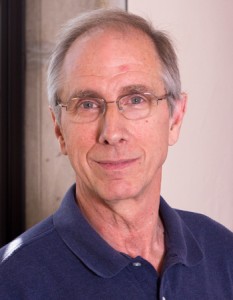
This pursuit of good work is framed by what I call ‘embracing the cycles’ or the ‘gift of the persistently possible,’ a gift Jim consistently doled out. Rather than lament about a particular situation or become mired in despair and anger, the Daniel Quinn novel Ishmael and the words story and opportunity soon would pop up in discussions with Jim. The narrator says, “They failed because you can’t just stop being in a story, you have to have another story to be in.” A given story might come to a close, yet another takes its place. The challenge is to rise up and recognize the new opportunity, the opportunity to use your gifts and talents to work with others who feel as passionately as you do to unfold the next story. This is jumping from the downcycle into the upcycle which can, at times, feel like you are actually in the spin cycle! Jim consistently encouraged all to step into their next story and to do so with gusto, whether it was students attempting to start an on-campus organic farm, a department trying to develop a revised curriculum, or a friend struggling to make sense of a life-changing event.
Just how does one step into the next story? In the liberal arts sense, we do it with thoughtfulness. Thoughtfulness embodied and expressed by people in the careful way they think and in how they care about other people and places. This kind of thinking and doing is hard work and certainly has its upcycles and downcycles. In parallel we do this as a spiritual journey or leap of faith. Our stories are deeply interconnected – making a tangled web of beauty reflective of God at work in the world. As the earth spins on its axis, meandering through space and time, may we have the courage to embrace our upcycles and downcycles to spin through life and see the gifts of the possible, in each other, in St. Olaf and in Creation. Thanks Jim, for encouraging all to see and practice a different kind of human-nature.
During the last two weeks we have enjoyed the Melbourne area during a break, journeyed to Canberra to see Parliament, discussed how environment plays into the political process and we now find ourselves in Sydney. The break allowed us to muse on various “Green” ideas, topics or just free form thoughts. As we reflect back on our first six weeks in country we ask, “Did we need to journey half-way around the world to appreciate how we are inextricably part of nature and to fully appreciate its wonder, diversity and beauty?”
From EnvSci Australia – 17 Mar 2012
During the last two weeks we have enjoyed the Melbourne area during a break, journeyed to Canberra to see Parliament, discussed how environment plays into the political process and we now find ourselves in Sydney. The break allowed us to muse on various “Green” ideas, topics or just free form thoughts.
As we reflect back on our first six weeks in country we ask, “Did we need to journey half-way around the world to appreciate how we are inextricably part of nature and to fully appreciate its wonder, diversity and beauty?”
Yes. How can we not see a place where over 50% of the plants and animals are endemic – found no where else on the globe? Along the southern coast of Victoria, the endemism of marine life is estimated at over 90%. You can’t find that characteristic of life near home. The country is dry – usually. The second La Nina year in a row is bringing

mild temperature and lots of rainfall to the SE region, which translated means moving from drought into flash flooding. Australia is perched in a unique climatic zone, so it is highly sensitive to small changes in global climatic cycles.
No. Our travel makes an impact. Certainly the 9500+ miles traveled from Minneapolis to Melbourne left a big carbon footprint, as does our coach travel around the country. Taking lunches, with all their packaging, also leaves behind a substantive energy and materials footprint. What can we do to change some of this and minimize our impacts? Last spring one of my EnvSt seniors did an audit of the program for her senior project. Certainly, one can apply offsets to our air travel or even do work in and around campus to mitigate this. We have pushed for more reusable containers and seek out eating establishments that have strong relationships to small, local farms. One of our favorites in Melbourne was the Affogato Cafe, located on Hardware Lane. The husband-wife team that operates this place were friendly, welcoming and big fans of the United States, especially New York, San Francisco and Memphis. Yes, they loved the music scene in Tennessee and the eclectic mix playing in the cafe was a delight to experience each day. The food was simple and delicious.
Another prompt to being green was not too far from our QUEST accommodation on Flinders Lane. Here you could walk about 30 meters to a few alleys filled with what I will call social, public art. Graffiti artist alter the visual landscape daily – putting layers of spray paint on top of previous work. This ever changing scene provides social commentary, highlights cultural differences, and expresses profound personal perspectives. The spray paint is not very green, but the response of other artists, citizens and tourist make it worth the look.
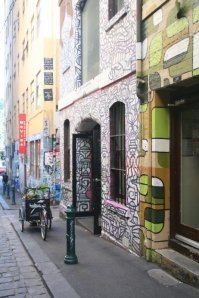

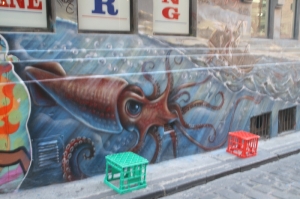
It would be difficult not to end a few green musings with policy. In Australia the federal government does not have environment or environmental issues written specifically into its constitution. These responsibilities primarily rest with each state government. What the Commonwealth does have are constitutional provisions for addressing foreign affairs, trade and international financing as specified by the external affairs section of the constitution (Section 51). Throughout the last 50 years the Commonwealth has been advancing environmental protection largely through being part of international treaties and multi-national environmental declarations. This was reviewed on a number of occasions by the High Court and subsequent common law gave the federal government more authority in this area. Our visit to the Commonwealth’s Parliament House was excellent. We were fortunate to see “question time” in the Parliamentary system (click link for a comparison with the USA). The images below show the provisional parliament house (white buildings in foreground) and the current parliament house (background with large flag spire and grassed roof). Inside the colors and materials reflect the Australian palette. In particular, the color of the House of Representatives is a grayish blue-green; the leaf color many acaias and eucalypts in Australia. For example, check out the leaf color of Eucalypts globulus (Blue gum) when it is young.

